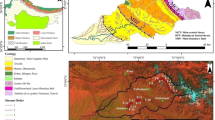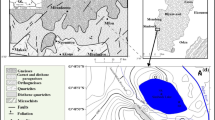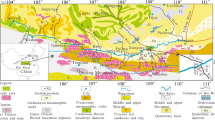Abstract
The Atrai River rises in the southeast Himalaya and empties into the Bengal Basin in the northwest. In this study, major and trace element geochemistry of the Atrai River sediments is carried out in addition to petrography to determine the compositional maturity, provenance, chemical weathering, and tectonic setting. X-ray fluorescence (XRF) spectrometry was employed for geochemical studies. Results reveal that, in comparison to the Upper Continental Crust (UCC), the sediments are significantly enriched in SiO2, Fe2O3, Cr, and Ni and markedly depleted in Na2O, MgO, CaO, MnO, and TiO2. This is likely because feldspars were lost during chemical weathering. The sediments of the Atrai River are sub-arkosic in composition. The index of compositional variability (ICV) (0.95 to 1.35), and SiO2/Al2O3 ratio (6.15 to 6.81) in the Atrai River sediments suggest poorly sorted grains, and low compositional and mineralogical maturity. The geochemical and petrographic discriminate diagrams and high Al2O3/TiO2 values (20.57 to 32.55) indicate a felsic igneous provenance for the Atrai River sediments. They are mainly derived from granitic sources, with subordinate metamorphic and pre-existing sedimentary sources. The Higher Himalayas and the Lesser Himalayas are considered the possible source areas of the Atrai River sediments. Weathering indices (CIA, CIW, and PIA), as well as major and trace element discriminating diagrams, point to a weak-to-moderate degree of chemical weathering that may be prevalent in the source area under semi-arid climatic conditions. Petrographic and geochemical discriminating diagrams reveal an active margin tectonic setting for the Atrai River sediments.













Similar content being viewed by others
Data Availability
The authors confirm that the data supporting the findings of this study are available within the article.
References
Abdullah R, Aurthy MR, Khanam F, Hossain M, ASM S (2022) Structural development and tectonostratigraphic evolution of the Sylhet Trough (northeastern Bengal Basin) in the context of Cenozoic Himalayan Orogeny: Insights from geophysical data interpretation. Mar Pet Geol 138:105544
Abdullah R, Sayem ASM, Yeasmin R, Rahman MM, Bari Z, Khanam F (2021) Plio-Pleistocene to Recent Tectonostratigraphic evolution of the Lalmai Anticline in the western Indo-Burman Range (Bangladesh): insights from lithofacies analysis and structural synthesis. Arab J Geosci 14:392
Abeden MJ, Rahman MJJ, Sayem ASM, Abdullah R (2017) Heavy mineral distribution in sand deposits from the lower reaches of the Jamuna River, Bangladesh. Bangladesh Geosci J 24:1–14
Ahmed T, Khanna PP, Chakranpani GJ, Balakrishnan S (1998) Geochemical characteristics of wate and sediment of the Indus River, Trans-Himalaya, India: constrians on weathering and eroison. J Asian Earth Sci 16:333–346
Al-Dousari A, Doronzo D, Ahmed M (2017) Types, indications and impact evaluation of sand and dust storms trajectories in the Arabian gulf. Sustainability 9:1526
Al-Hemoud A, Al-Dashti H, Al-Saleh A et al (2022) Dust storm ‘hot spots’ and transport pathways affecting the Arabian Peninsula. J Atmos Sol Terr Phys 238-239:105932
Armstrong-Altrin J, Verma SP (2005) Critical evaluation of six tectonic setting discrimination diagrams using geochemical data of Neogene sediments from known tectonic setting. Sediment Geol 177:115–129
Armstrong-Altrin JS, Lee YI, Kasper-Zubillaga JJ, Trejo-Ramírez E (2017) Mineralogy and geochemistry of sands along the Manzanillo and El Carrizal beach areas, southern Mexico: implications for palaeoweathering, provenance, and tectonic setting. Geol J 52:559–582
Armstrong-Altrin JS, Machain-Castillo ML, Rosales-Hoz L, Carranza-Edwards A, Sanchez-Cabeza J, Ruíz-Fern Andez AC (2015) Geochemistry of deep sea sediments from the south-western Gulf of Mexico, Mexico: implication for depositional environment. Cont Shelf Res 95:15–26
Armstrong-Altrin JS, Madhavaraju J, Vega-Bautista F, Ramos-Vazquez MA, Perez-Alvarado BY, Kasper-Zubillaga JJ, AZE B (2021) Mineralogy and geochemistry of Tecolutla and Coatzacoalcos beach sediments SW Gulf of Mexico. Appl Geochem 134:105103
Armstrong-Altrin JS, Nagarajan R, Madhavaraju J, Rosalez-Hoz L, Lee YI, Balaram V, Cruz-Martinez A, Avila-Ramirez G (2013) Geochemistry of the Jurassic and upper Cretaceous shales from the Molango Region, Hidalgo, Eastern Mexico: implications of source-area weathering, provenance, and tectonic setting. Geoscience 345:185–202
Bayon G, Toucanne S, Skonieczny C, André L, Bermell S, Cheron S et al (2015) Rare earth elements and neodymium isotopes in world river sediments revisited. Geochim Cosmochim Acta 170:17–38
Bhatia MR (1983) Plate tectonics and geochemical composition of sandstones. J Geol 91:611–627
Bhuiyan MAH, Rahman MJJ, Dampare SB, Suzuki S (2011) Provenance, tectonics and source weathering of modern fluvial sediments of the Brahmaputra–Jamuna River, Bangladesh: Inference from geochemistry. J Geochem Explor 111:113–137
Condie KC (1967) Geochemistry of early Precambrian greywackes from Wyoming. Geochim Comochim Acta 31:2135–2149
Condie KC, Noll PD, Conway CM (1992) Geochemical and detrital mode evidence for two sources of Early Proterozoic metasedimentary rocks from the Tonto Basin upergroup, central Arizona. Sediment Geol 77:51–76
Cox R, Lowe DR, Cullers RL (1995) The influence of sediment recycling andbasement composition on evolution of mudrock chemistry in the southwestern United States. Geochim Cosmochim Acta 59:2919–2940
Critelli S, Ingersoll RV (1994) Sandstone petrology and provenance of the Siwalik Group (northwestern Pakistan and western-southeastern Nepal). J Sediment Res 64:815–823
Cullers RL (1995) The controls on the major and trace element evolution of shales, siltstones and sandstones of Ordovician to Tertiary age in the Wet Mountain region, Colorado, U.S.A. Chem Geol 123:107–131
Cullers RL (2000) The geochemistry of shales, siltstones and sandstones of Pennsylvanian-Permian age, Colorado, USA: implications for provenance and metamorphic studies. Lithos 51:181–203
Dasgupta S, Ganguly J, Neogi S (2004) Inverted metamorphic sequence in the Sikkim Himalayas: crystallization history, P-T gradient, and implications. J Metamorph Geol 22:395–412
Dickinson WR (1985) Interpreting provenance relations from detrital modes of sandstone. In: Zuffa (ed) Provenance of arenites. Advanced Study Institute Series, D. Reidel Publishing Company, Dordrecht, The Netherlands
Dickinson WR, Beard LS, Brakenridge GR, Erjavec JL, Ferguson RC, Inman KF, Knepp RA, Lindberg FA, Ryber PT (1983) Provenance of North American Phanerozoic sandstones in relation to tectonic setting. Geol Soc Am Bull 94:222–235
Dickinson WR, Suczek CA (1979) Plate tectonics and sandstone compositions. AAPG Bull 63:2164–2182
Doronzo DM (2012) Two new end members of pyroclastic density currents: forced convection-dominated and inertia-dominated. J Volcanol Geotherm Res 219:87–91
Fedo CM, Nesbitt HW, Young GM (1995) Unraveling the efects of potassium metasomatism in sedimentary rocks and paleosols, with implications for paleoweathering conditions and provenance. Geology 23:21–924
Folk RL, Ward WC (1957) Brazos River bar, a study in the significance of grain size parameters. J Sediment Petrol 27:3–26
Galy A, France-Lenord C (2001) Higher erosion rates in the Himalaya: geochemical constrains on riverine fluxes. Geology 29:23–26
Garver JI, Royce PR, Smick TA (1996) Chromium and nickel in shale of the Taconic Foreland: a case study for the provenance of fie-grained sediments with an ultramafic source. J Sediment Res 66:100–106
Goto A, Tatsumi Y (1994) Quantitative analysis of rock samples by an X-ray fluorescence spectrometer (I). The Rigaku Journal 11:40–59
Goto A, Tatsumi Y (1996) Quantitative analysis of rock samples by an X-ray fluorescence spectrometer (II) [J]. Rigaku J 13:20–38
Harnois L (1988) The CIW index: a new chemical index of weathering. Sediment Geol 55:319–322
Hayashi K, Fujisawa H, Holland HD, Ohmoto H (1997) Geochemistry of 1.9 Ga sdimentary rocks from northeastern Labrador Canada. Geochim Cosmochim Acta 61:4115–4137
He Z, Guo ZT, Yang F, Sayem ASM, Wu H, Zhang Z, Hao Q, Xiao G, Han L, Fu Y, Wu Z, Hu H (2019) Provenance of Cenozoic sediments in the Xining Basin revealed by Nd and Pb isotopic evidence: implications for tectonic uplift of the NE Tibetan Plateau. Geochem Geophys Geosyst 20:4531–4544
Herron MM (1988) Geochemical classification of terrigenous sands and shales from core or log data. J Sediment Petrol 58:820–829
Hossain HMZ (2019) Major, trace, and REE geochemistry of the Meghna River sediments, Bangladesh: constraints on weathering and provenance. Geol J 55:3321–3343
Huyan Y, Yao W, Wang L (2021) Provenance, source weathering, and tectonics of the Yarlung Zangbo River overbank sediments in Tibetan Plateau, China using major, trace, and rare earth elements. Geol J 57:37–51
Jacobson AD, Blum JD, Chamberlain CP, Craw D, Koons PO (2003) Climatic and tectonic controls on chemical weathering in the New Zealand Southern Alps. Geochim Cosmochim Acta 67:29–46
Kundu A, Matin A, Eriksson PG (2016) Petrography and geochemistry of the Middle Siwalik sandstones (tertiary) in understanding the provenance of sub-Himalayan sediments in the Lish River Valley, West Bengal India. Arab J Geosci 9:162
Le Bas MJ, Le Maitre RW, Streckeisen A, Zanettin B (1986) A chemical classification of volcanic rocks based on the total alkali–silica diagram. J Petrol 27:745–750
Li L, Ni J, Chang F, Yue Y, Frolova N, Magritsky D et al (2020) Global trends in water and sediment fluxes of the world’s large rivers. Sci Bull 65:62–69
Long X, Yuan C, Sun M, Xiao W, Wang Y, Cai K, Jiang Y (2012) Geochemistry and Nd isotopic composition of the Early Paleozoic flysch sequence in the Chinese Altai, Central Asia: evidence for a northward-derived mafic source and insight into model ages in an accretionary orogen. Gondwana Res 22:554–566
Mange MA, Maurer HFW (1992) Heavy minerals in color. Chapman and Hal, London, p 133
McLennan SM (1989) Rare earth elements in sedimentary rocks: influence of provenance and sedimentary processes. Rev Mineral 21:169–200
McLennan SM, Hemming S, McDaniel DK, Hanson GN (1993) Geochemical approaches to sedimentation, provenance, and tectonics. In: Basu, A., Johnsson, M.J. (Eds.), Processes controlling the composition of clastic sediments. Geol Soc Am Spec Pap 284:21–40
Najman Y, Bickle M, BouDagher-Fadel MK et al (2008) The Paleogene record of Himalayan erosion: Bengal Basin, Bangladesh. Earth Planet Sci Lett 273:1–14
Nesbitt HW, Young GM (1982) Early Proterozoic climates and plate motions inferred from major element chemistry of lutites. Nature 299:715–717
Nesbitt HW, Young GM (1984) Prediction of some weathering trends of plutonic and volcanic rocks based on thermodynamic and kinetic considerations. Geochim Cosmochim Acta 48:1523–1534
Noa Tang SD, Ntsama Atangana J, Onana VL (2020) Mineralogy and geochemistry of alluvial sediments from the Kadey plain, eastern Cameroon: implications for provenance, weathering, and tectonic setting. J Afr Earth Sci 163:103763
Parker A (1970) An index of weathering for silicate rocks. Geol Mag 107:501–504
Pettijohn FJ, Potter PE, Siever R (1972) Sand and sandstone. Plate motions inferred from major element chemistry of lutites. Precambrian Res 147:124–147
Potter PE (1978) Petrology and chemistry of modern big river sands. J Geol 86:423–449
Rahman MJJ, Sayem ASM, Bhuiyan MH (2014a) Geochemistry of the Plio–Pleistocene Dupi Tila sandstones from the Surma Basin, Bangladesh: implications for provenance, tectonic setting and weathering. Himal Geol 35:162–170
Rahman MJJ, Sayem ASM, McCann T (2014b) Geochemistry and provenance of the Miocene Sandstones of the Surma Group from the Sitapahar Anticline, southeastern Bengal Basin, Bangladesh. J Geol Soc India 83:447–456
Rahman MJJ, Xiao W, Hossain MS, Yesmin R, Sayem ASM, Ao S, Yang L, Abdullah R, Dina NT (2020) Geochemistry and detrital zircon U-Pb dating of Pliocene-Pleistocene sandstones of the Chittagong Tripura Fold Belt (Bangladesh): implications for provenance. Gondwana Res 78:278–290
Rahman MM, Arya DS, Goel NK, Dhamy AP (2011) Design fow and stage computations in the Teesta River, Bangladesh, using frequency analysis and MIKE 11 modeling. J Hydrol Eng 16:176–186
Ranjan N, Bannerjee DM (2009) Central Himalayan crystallines as the primary source for the sandstone–mudstone suites of the Siwalik Group: new geochemical evidence. Gondwana Res 6:687–696
Rosales-Lagarde L, Centeno-García E, Dostal J, Sour-Tovar F, Ochoa-Camarillo H, Quiroz-Barroso S (2005) The Tuzancoa Formation: evidence of an Early Permian submarine continental Arc in East-Central Mexico. Int Geol Rev 47:901–919
Roser BP, Korsch RJ (1986) Determination of tectonic setting of sandstone-mudstone suites using SiO2 content and K2O/Na2O ratio. J Geol 94:635–650
Roser BP, Korsch RJ (1988) Provenance signatures of sandstone-mudstone suites determined using discrimination function analysis of major element data. Chem Geol 67:119–139
Roser BP, Cooper RA, Nathan SA, Tulloch AJ (1996) Reconnaissance sandstone geochemistry, provenance, and tectonic setting of the lower Paleozoic terrains of the West Coast and Nelson, New Zealand. N Z J Geol Geophys 39:1–16
Ruddiman WF (2008) Earth’s climate: past, present and future. WH Freeman and Company, New York, p 387
Sayem ASM, Guo ZT, Wu H, Zhang C, Yang F, Xiao G, He Z (2018) Sedientary and geochemical evidence of Eocene climate change in the Xining Basin, northeastern Tibetan Plateau. Sci China Earth Sci 61:1292–1305
Sayem ASM, Shoshi KF, Rokonuzzaman M, Abeden MJ, Bari Z (2021) Textural and heavy mineral characteristics of the bar sediments from the upper reaches of the Atrai River, northwest Bangladesh. Bangladesh Geosci J 27:17–41
Singh P (2010) Geochemistry and provenance of stream sediments of the Ganga River and its major tributaries in the Himalayan region India. Chem Geol 269:220–236
Suttner LJ, Dutta PK (1986) Alluvial sandstone composition and paleoclimate framework mineralogy. J Sediment Petrol 56:329–345
Taylor SR, McLennan SM (1985) The continental crust: its composition and evolution. an examination of the geochemical record preserved in sedimentary rocks. Blackwell Science, Oxford
Torres-Sanchez D, Verma SK, Verma SP, Velasco-Tapia F, Torres-Hernandez JR (2019) Petrogenetic and tectonic implications of Oligocene-Miocene volcanic rocks from the Sierra de San Miguelito complex, central Mexico. J S Am Earth Sci 95:102311
Uddin A, Lundberg N (1998) Unroofing history of the eastern Himalaya and the Indo–Burman ranges: heavy mineral study of Cenozoic sediments from the Bengal Basin, Bangladesh. J Sediment Res 68:465–472
Verma SP (2015) Origin, evolution, and tectonic setting of the eastern part of the Mexican Volcanic Belt and comparison with the Central American Volcanic Arc from conventional multielement normalized and new multidimensional discrimination. Turk J Earth Sci 24:111–164
Verma SP, Armstrong-Altrin JS (2013) New multi-dimensional diagrams for tectonic discrimination of siliciclastic sediments and their application to Precambrian basins. Chem Geol 355:117–180
Viers J, Dupré B, Gaillardet J (2009) Chemical composition of suspended sediments in World Rivers: new insights from a new database. Sci Total Environ 407:853–868
Wentworth CK (1922) A scale of grade and class terms for clastic sediments. J Geol 30:377–392
Wronkiewicz DJ, Condie KC (1987) Geochemistry of Archean shales from the Witwatersrand Supergroup, South Africa: source-area weathering and provenance. Geochim Cosmochim Acta 51:2401–2416
Wronkiewicz DJ, Condie KC (1990) Geochemistry and mineralogy of sediments from the Ventersdorp and Transvaal Supergroups, South Africa: Cratonic evolution during the early Proterozoic. Geochim Cosmochim Acta 54:343–354
Yang L, Xiao WJ, Rahman MJJ et al (2020) Indo-Burma passive amalgamation along the Kaladan Fault: insights from zircon provenance in the Chittagong-Tripura Fold Belt (Bangladesh). GSA Bull 132:1953–1968
Zaid SM (2015) Geochemistry of sandstones from the Pliocene Gabir Formation, north Marsha Alam, Red sea, Egypt: implication for provenance, weathering and tectonic setting. J Afr Earth Sci 102:1–17
Acknowledgements
The authors are also grateful to the Institute of Mining, Mineralogy and Metallurgy (IMMM), BCSIR, for allowing us in their XRF laboratory. A special thanks goes to Mr. Masum Shah for his kind cooperation during the field work.
Funding
This work is funded by the Faculty of Physical and Mathematical Sciences, Jahangirnagar University.
Author information
Authors and Affiliations
Corresponding author
Ethics declarations
Conflict of interest
The authors declare that they no competing interests.
Additional information
Responsible Editor: Domenico M. Doronzo
Rights and permissions
Springer Nature or its licensor (e.g. a society or other partner) holds exclusive rights to this article under a publishing agreement with the author(s) or other rightsholder(s); author self-archiving of the accepted manuscript version of this article is solely governed by the terms of such publishing agreement and applicable law.
About this article
Cite this article
Sayem, A.S.M., Rokonuzzaman, M., Shahriar, M.S. et al. Major and trace element geochemistry of the Atrai River sediments from the Bengal Basin (Bangladesh): implication for provenance, chemical weathering, and tectonic setting in the southeastern Himalaya. Arab J Geosci 16, 487 (2023). https://doi.org/10.1007/s12517-023-11599-4
Received:
Accepted:
Published:
DOI: https://doi.org/10.1007/s12517-023-11599-4




